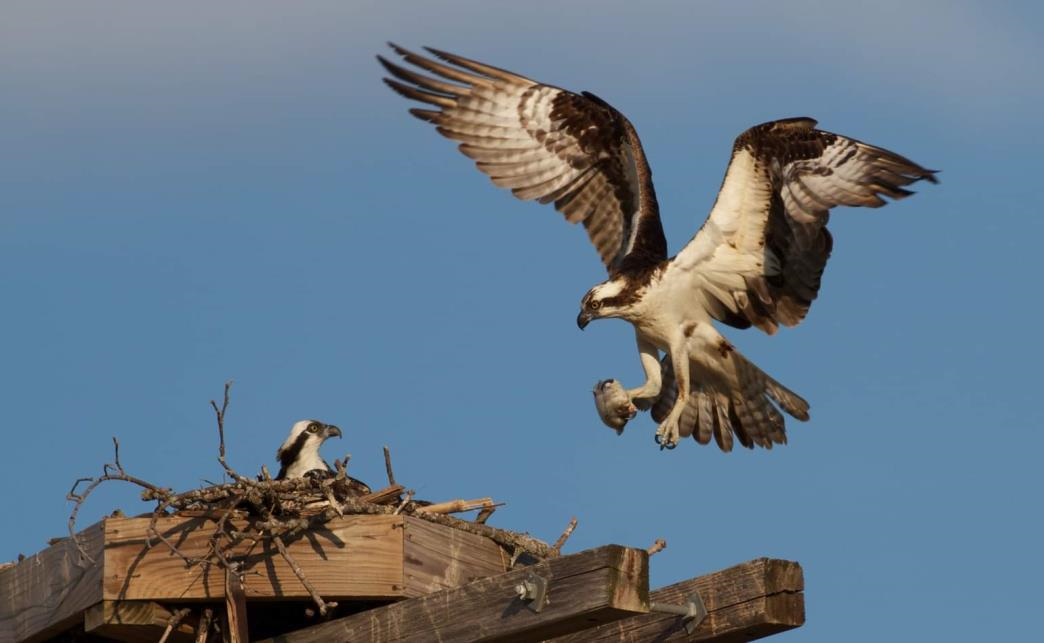Welcome home Harry and Flora! Famous Alyth ospreys return to nesting platform for summer
Two resident ospreys have made the return trip from Africa to Alyth to their purpose-built residential nesting platform close to SSEN Transmission’s Alyth substation.
The two ospreys, named Harry and Flora by pupils from nearby Meigle Primary School last year, returned after migrating south for the winter.
Female osprey Flora was spotted first in early April and was soon joined by male osprey Harry a few days later.
A special live osprey camera is up and running again for this year’s breeding season so avid bird-watchers can keep track of the famous Alyth residents. Last year the live channel attracted over 2,000 subscribers, as fans flocked to check on the progress of the ospreys.
In 2022 Harry and Flora reared three healthy chicks – named Rowan, Holly and Bonnie – who all successfully took flight from the nest to make the long journey south for the winter in September.
The Alyth substation team are hopeful for more chicks this year, which will take the number of osprey chicks successfully reared from the new platform to 17 since it was built in 2014.
As with previous years, the birds are carefully monitored by an on-site ornithologist throughout the nesting season to ensure any construction work doesn’t cause any disturbance to the ospreys.
The nesting platform was first created in 2014 as an alternative home for the ospreys ahead of the start of a programme of upgrade and reinforcement work to the transmission East Coast network, after the birds were spotted nesting at the top of one of SSEN Transmission’s 48-metre-high electricity towers which was scheduled for maintenance as part of the project.
SSEN Transmission Consents and Environment Manager Ewan Jelly said:
“It is fantastic to welcome home Flora and Harry back to their nesting platform again this year after their long journey from their winter migration area in Africa, and already we’re closely monitoring the birds as they prepare the nest for this year’s breeding season.
“They are firm favourites with the teams here working on the Alyth substation project, and it’s a real joy seeing them return to the nest and take to the skies as they hunt for fish in the nearby rivers and lochs.
“The live camera link means we can continue to keep a close eye on the much-loved ospreys, and share them with a wider audience including the local community and ospreys enthusiasts alike.
“The pupils at Meigle Primary School did a terrific job in coming up with names for Harry and Flora as well as their three chicks last year, and I know they’ll be excited to hear that their favourite birds are back from their migration.
“As ever we’ll continue to observe the birds closely to check on their progress and monitor for any signs of distress, and we look forward to hopefully welcoming more chicks again later this year.”
The construction of the Alyth substation is part of a wider scheme to upgrade the East Coast Transmission network. Once complete it will enable the connection of new renewable generation to the grid, helping to facilitate the transmission to net zero emissions. The project at Alyth is on course to be completed in by the end of 2023.
SSEN Transmission has made sector-leading biodiversity commitments on all projects, introducing a policy of no-net-loss in biodiversity on all projects gaining consent from 2020, and biodiversity net gain on all new projects from 2025. This means teams will leave the environment no worse than when they found it, and where possible making it even better, leaving a positive environmental legacy at all SSEN Transmission sites.
Initial studies and monitoring for the Alyth substation have highlighted a significant benefit in biodiversity around the site, with a current forecasted figure of an increase of 50%. Teams have created various ecological improvements around the site which has helped to encourage native species of flora and fauna around the perimeter of the substation compound, contributing to a positive net gain in biodiversity, including planting over 5,400 native trees, sowing native grass and wildflower seeds and installing various nesting and feeding boxes for bats, birds and red squirrels.
Learn more about the project here: https://www.ssen-transmission.co.uk/projects/project-map/alyth-275kv-substation--reactive-compensation/
Further information:
- View the live webcam to the osprey nest here: https://youtu.be/be6Wef2Mv5U
- Ospreys normally nest in large mature trees. This iconic species feeds almost entirely on fish which they capture in a spectacular fashion by swooping down and snatching them from near the surface in their talons. Ospreys are migratory with the majority spending their winter in West Africa (although a small number of ospreys spend their winter in Iberia). Ospreys are a protected species, and it is an offence to intentionally or recklessly disturb the birds close to their nest during the breeding season.
